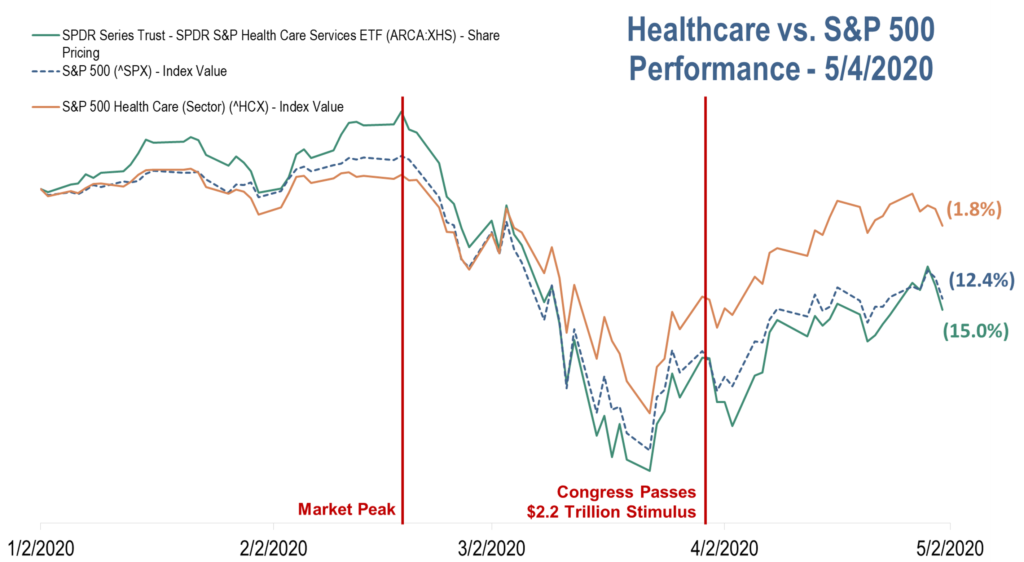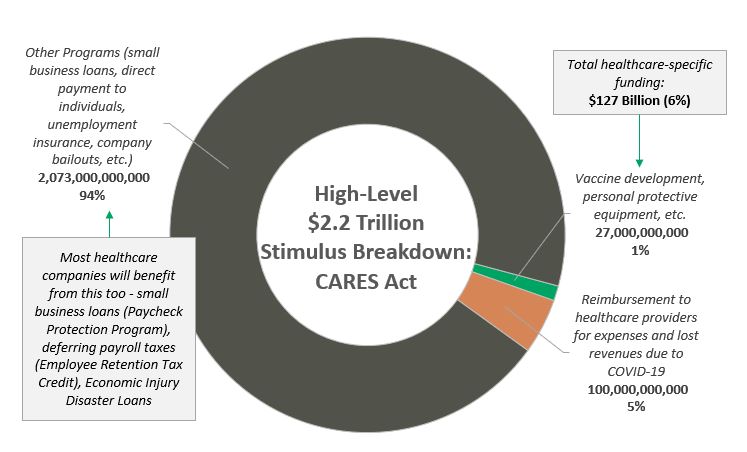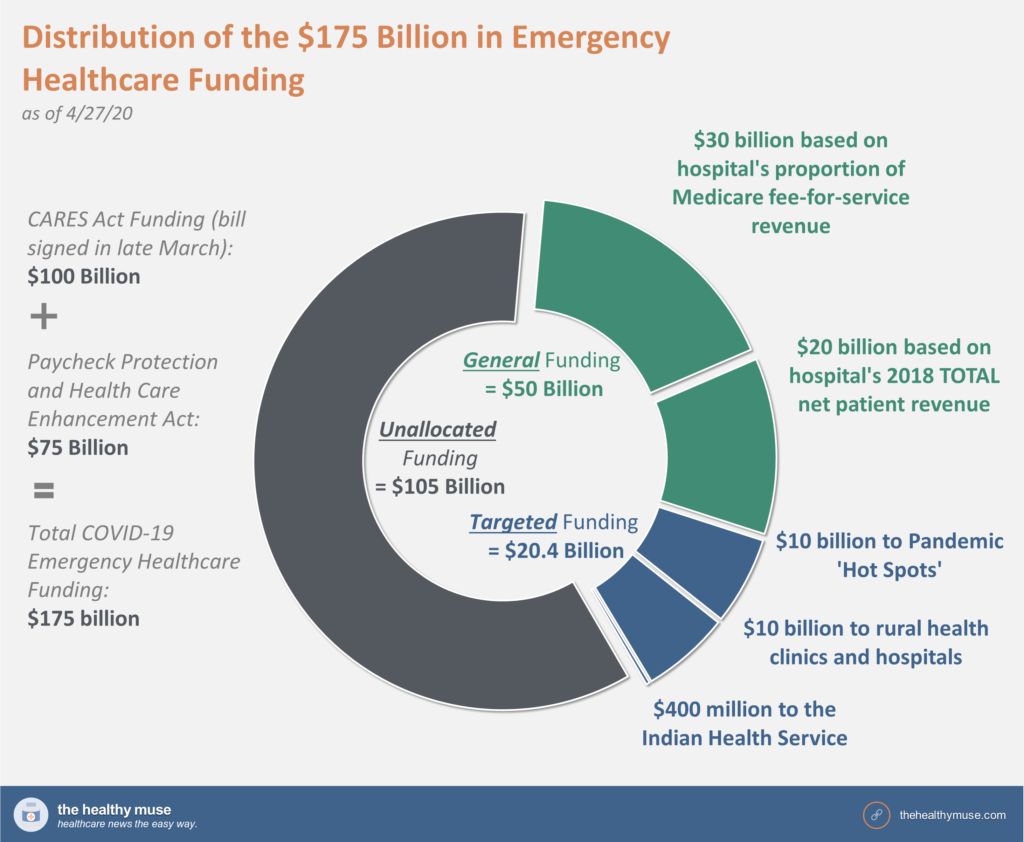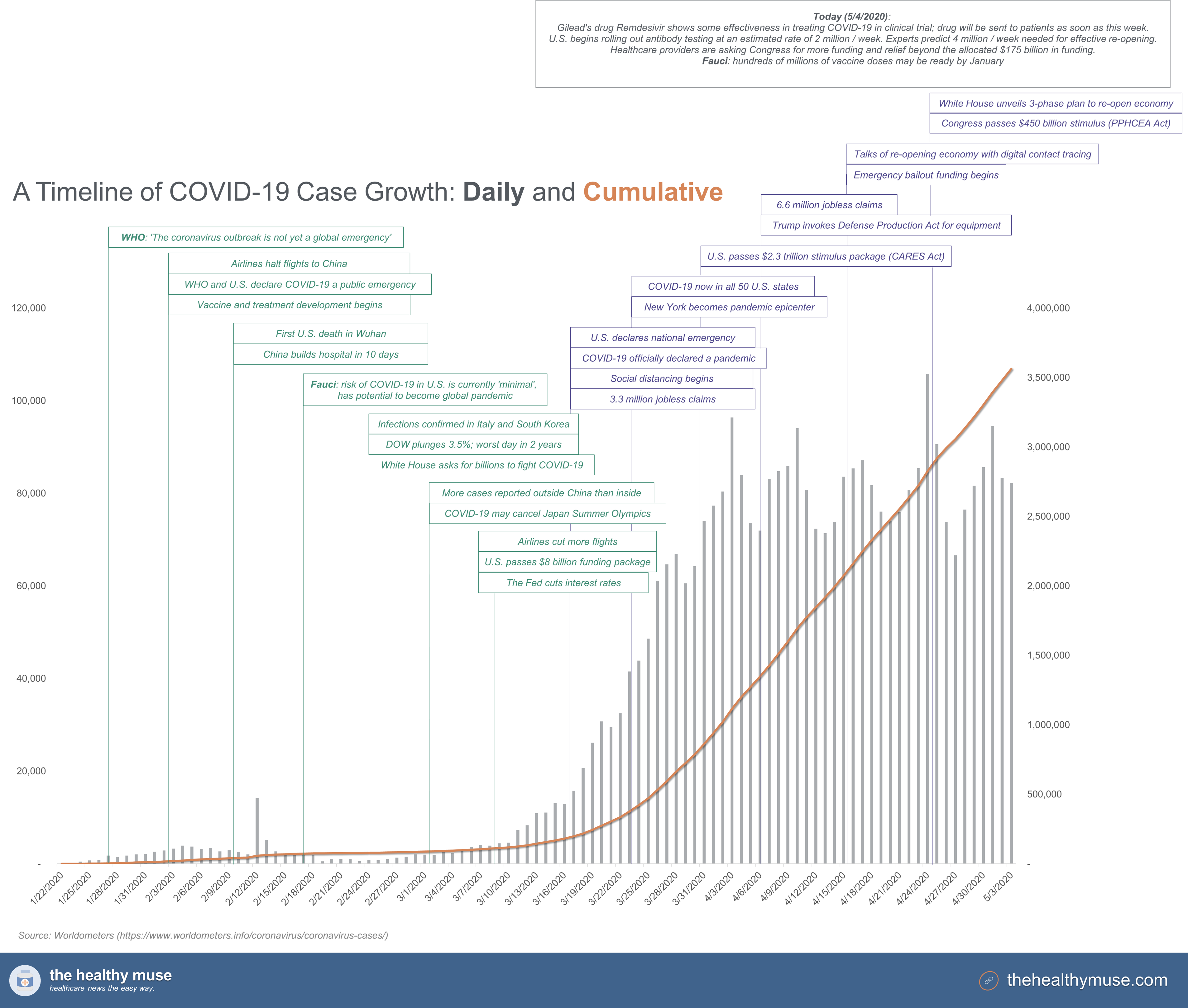The most important stories to know in order to follow the coronavirus timeline.
It’s no surprise that there have been plenty of news headlines since the coronavirus timeline began.
Here at the Healthy Muse, we stick to the facts and spot the high-level trends happening rather than read all of the fearmongering and sensationalized stories out there.
If you want a healthcare newsletter that sticks to the facts, is non-partisan, and gives you healthcare news, trends, and analysis in a 5-minute read, then give us a try by subscribing here.
For that reason, I made this coronavirus timeline that follows most of the pandemic period – from the end of January to today (May 4).
Here are the coronavirus timeline’s biggest stories and things you should know:
January 27, 2020: we know where this is headed.
While last week the number of infected was sitting at 650 worldwide, the total reported cases was about 2,800. A majority of these infections occurred in Wuhan.
40 total cases have been spotted outside of China – 5 officially reported within the U.S.
The markets sold off Monday as fears spread about a potential epidemic. Companies like Disney, Starbucks, and McDonald’s are suspending their operations during what is normally a higher level of consumer spending activity in China with Lunar New Year celebrations. Here’s more info from Axios on the potential economic impact of the virus.
Officials have criticized China’s response to the outbreak, blaming the regime’s tendency for censorship while the virus spreads.
The virus is highly contagious and has a somewhat high mortality rate. Companies like J&J and Moderna are working on a vaccine, but it could take up to a year to bring it to market.
With all of this news coverage, I can’t help but think we’re all just playing the popular video game Pandemic – which, ironically, saw a spike in sales over the weekend.
WHO: The coronavirus is not yet a global emergency.
February 3, 2020: a public health emergency.
Airlines are halting flights to China, Chinese markets are selling off, and most companies and institutions in the U.S. are erring on the side of caution, the WSJ reports.
Axios is covering the number of infected with a live updating article. (over 17,000 infected, mainly in China). Earlier in the week, the U.S. didn’t think it was a big deal. The WHO disagreed, calling it a public health emergency. Then that Friday, the U.S. went ahead and declared the same.
There were 7,000 people stuck on a cruise in Italy because of it.
Johnson & Johnson says they’ve already started development on a coronavirus vaccine. After a rough couple of years in the spotlight for the wrong reasons, I’m sure J&J is looking for ways to make up some goodwill. Other biotechs like Gilead and GlaxoSmithKline are jumping on the coronavirus train too.
The virus might affect the global biopharma supply chain, since a lot of drugs and ingredients are produced in China.
Artificial Intelligence is actually being put to very practical use in predicting the global spread of the virus. In fact, an algorithm detected the outbreak a week before the CDC.
February 10, 2020: China’s healthcare system hits its breaking point.
As of February 10, the number of infected was ~41k and reported deaths at ~1k.
China built a hospital in 10 days. The first American died from the virus in Wuhan over this weekend. And here’s a feature piece from the WSJ on a Chinese healthcare system past the brink with the Coronavirus in full force.
Meanwhile, an AI simulation model is predicting that the Coronavirus will infect 2.5 billion people.
February 17, 2020: spreading to South Korea and Italy.
COVID-19 infections were confirmed in Italy and South Korea.
The DOW plunged 3.5%, its worst day in 2 years.
The White House asked Congress for billions in funding to combat COVID-19.
February 24, 2020: Chinese infections decline.
Chinese infections have started to decline, but experts think the cases are just hard to spot.
The WHO releases a statement that the ability to contain the coronavirus outbreak has decreased significantly.

March 2, 2020: Summer Olympics cancelled?
The White House is requesting more emergency funding.
The coronavirus might affect the summer Olympics in Japan. And the CDC is bracing for a U.S. outbreak that might lead to medical supply shortages.
March 9, 2020: cancellations everywhere
Conferences like HIMSS and SXSW are getting canceled. Airlines are cutting flights. South Korea is a coronavirus testing machine.
The U.S. funded an $8 billion emergency package, part of which lifts Medicare’s restrictions on telehealth. On that note, Teladoc’s stock is surging on the prospects of virtual care.
Biotech firms are tapping into (WSJ paywall) A.I. to speed up drug development. A mass-produced vaccine/drug will still take 18 months to get here. Meanwhile, stocks are tanking across the globe.
March 16, 2020: officially a pandemic.
Things have developed quickly. It’s officially a pandemic. Retail closures, restaurant closures, and a ban on events with over 50 people.
COVID-19 will push back the interoperability timeline.
Health insurers are expected to experience moderately elevated medical loss ratios.
March 23, 2020: a possible treatment?
The coronavirus officially enters all 50 states.
New York becomes the global epicenter of the pandemic.
Hydroxychloroquine and chloroquine, old drugs used for malaria treatment, have shown limited promise in treating coronavirus.
March 30: 2020: an unprecedented $2.3 trillion stimulus in the CARES Act.
Good news: Abbott Labs just developed a portable, 5-minute coronavirus test.
The coronavirus peak is expected in mid-April.
Learn more from the WSJ (should be free – no paywall) about how the coronavirus attacks the body.
The White House just extended its social distancing guidelines until April 30. Previously, Trump was considering an enforceable quarantine on the broader New York area, including parts of New Jersey and Connecticut.
Johnson & Johnson is looking to begin clinical trials on humans for its COVID vaccine as soon as September
Someone is always looking to make a quick buck: Trump had to sign an executive order preventing price gouging and hoarding of medical supplies.
The first federal inmate died from coronavirus.
Congress passed the CARES Act, the largest fiscal stimulus in the history of the U.S. Here’s what’s inside:

The FDA will allow doctors to treat critically ill coronavirus patients with blood from survivors.
A shortage of protective gear is stalling CVS’ drive thru testing rollouts.
A consortium of 15 medical and tech firms formed a COVID-19 alliance, aimed at #FlatteningtheCurve
Amid mounting shortage, 5 facts about the nation’s stockpile of emergency medical supplies
ICU Bed capacity, similar to acute care hospital bed capacity, varies widely nationwide.
Payors like Aetna are beginning to waive cost-sharing requirements for patients related to COVID-19 as a gesture of goodwill.
How health systems are responding as COVID-19 squeezes the medical supply chain
Fauci says US needs to be prepared for coronavirus to be cyclical
Shuttered hospitals are re-opening across the U.S. solely for coronavirus cases.
Medtronic is publishing its ventilator’s design specs to the public so that more production can ramp up quickly.
April 6, 2020: military measures.
As of April 6, 2020 – 1,290,896 confirmed cases and 70,653 deaths from the coronavirus
A live look at the U.S. COVID-19 situation – by county
Trump invoked the Defense Production Act to increase ventilator manufacturing. The administration is making sure the federal government is first in line to receive crucial medical supplies by invoking the act.
Hospitals are facing shortages of critical supplies, according to a watchdog report – to the point that states and counties are squabbling and outbidding each other over supply needs.
The CDC recommends face masks for everyone.
Molina Healthcare is expanding Teladoc services to all of its members. As we’ve mentioned, Teladoc has been a huge winner in all of this.
April 13, 2020: an end in sight?
Everyone is starting to wonder when the economy will re-open. With the improving condition in New York and the effective social distancing measures, state governors across the nation are discussing when to open things back up, something Trump says he only has the power to do.
In any scenario, the economy is expected to re-open slowly.
Officials are mulling over the idea of tracing people’s contact with one another via blue tooth in people’s cellphones in order to combat virus spread.
While proponents of privacy are sure to riot, a short term national surveillance system may end up being the best way to re-open economic activity.
Social distancing is working and is reducing deaths – by a LOT.
Thousands of tests are going unused in labs.
The best hopes for a coronavirus drug.
Government payments to healthcare providers are starting to flow, mainly with hospitals. HHS is using UnitedHealth, AKA health insurance giant Numero Uno, to distribute $30 billion in relief funding to hospitals.
April 20, 2020: a re-opening plan emerges.
We’re re-opening the economy – slowly – and states will get to choose how and when that’s done. They’ll use the White House’s 3-phase approach as a guide.
Antibody and other lab testing availability will be key. If you read anything healthcare related this week, read this piece from Stat. They’ve been at the forefront of reporting re: everything coronavirus. Second, read this piece from the WSJ.
More bailout $$$ is on the way for small businesses and hospitals.
The CDC is releasing a clinical reporting tool in May.
Gilead’s antiviral drug treatment Remdesivir is showing cautiously optimistic results.
Trump halted funding for the World Health Organization pending investigation.
New projected COVID-19 peaks by state.
Contamination at the main CDC lab in Atlanta delayed tests for weeks, according to the NY Times.
More bailout cash is coming for small businesses – $450 billion in total, $300 billion of which is slated for the paycheck protection program.
Notably for healthcare, another $75 billion in bailout $$$ is coming to hospitals on top of the $100 billion fund already approved in the CARES Act. The news comes days after the American Hospital Association asked Congress – specifically the House – for more hospital funding.
Total healthcare emergency funding now sits at $175 billion and is getting split up as follows:

About that CARES Act money… CMS is distributing another round of $30 billion to hospitals. $20 billion will be based on each hospitals’ proportion of total revenue received from private insurers and Medicaid. Then, the remaining $10 billion will be dispersed based on coronavirus need – i.e., addressing “hot spots,” or hospitals with large numbers of coronavirus patients.
In an interesting twist, private equity owned physician practices were shut out of the CARES Act bailout funds.
Remember: The first round of funding was distributed based on hospitals’ historical shares of Medicare revenue, which drew some backlash.
We might have to sacrifice some temporary privacy and personal freedom in order to track infections. Here’s one way to balance the two.
CMS just provided guidance for resuming elective procedures. It’ll depend on the availability of personal protective equipment and declines in COVID cases.
Antibody treatments may be the best hope against the virus until a vaccine.
Americans rally to protest social distancing
April 27, 2020: antibody testing rolls out, and Remdesivir the silver bullet?
As of April 27: 993,852 infected in the U.S. and 56,009 deaths (Live Tracker) (Global Tracker). The CDC just updated COVID-19’s list of possible symptoms with 6 more ailments.
Certain states like Georgia and Tennessee are easing coronavirus restrictions, opening up restaurants and retail stores – and notably for healthcare, elective procedures.
Testing, a crucial component of re-opening, is increasing. Slowly.
Antibody testing in places like New York indicate that a lot more people have had the coronavirus than previously thought (which implies a lower death rate).
Hydroxychloroquine probably doesn’t work. Remdesivir, an antiviral drug made by pharma giant Gilead, might work? Here are some other drugs and treatments that could help, too. And what about a common heartburn drug?
The WHO is warning that the pandemic is far from over and causing shortages in OTHER vaccines.
New York state’s health department is mapping the coronavirus genome.
There’s no end in sight to coronavirus-related stimulus spending.
Despite allegations that HHS secretary Alex Azar was getting the boot, Trump says Azar is staying.
A $46.5 billion plan pitched for COVID-19 tracing – with primary care physicians at the center of it.
A detailed guide for state and local governments to consult before re-opening anything.
May 4, 2020: infections level off while states re-open. Also, ‘Operation Warp Speed.’
This week, Quest, Labcorp, and other laboratory testing providers began rolling out direct-to-consumer antibody tests, which tell you whether or not you’ve had the ‘Rona.
In addition, CVS is continuing its swab-testing rollout to 1,000 locations. Walgreens has drive-thru testing in 49 states.
And Rite Aid is expanding its testing in a partnership with Verily, a healthcare startup backed by Google.
While current testing capacity sits at an estimated 2 million tests per week, public-health doctors are estimating that total testing must be around 4 million per week in order to appropriately capture all of the coronavirus cases and prevent further spread.
Fun fact: the government has renamed the vaccine development project to ‘Operation Warp Speed.‘ Their goal is to have 300 million vaccine dosages ready by January by combining both private (biotech companies) and public resources (military and government agencies).
How the coronavirus mutates and spreads. (NY Times)
The FDA is cracking down on fraudulent antibody testing (scumbags…) – (WSJ)
Medical diagnostic testing and cancer screenings have plummeted during the pandemic – leading many worried about future health outcomes
Apple and Google released a first look at the COVID-19 digital tracing API. Take a closer look at how it works here.
Thanks for reading my version of the coronavirus timeline. I’m out. @B_Madden4
About the Healthy Muse.
The Healthy Muse was created to educate people on the healthcare system. It’s a once-weekly e-mail updating you on all the major election news, broader trends, big stories, and policy updates. Learn more about our vision here.
- Get smarter and sign up today.
